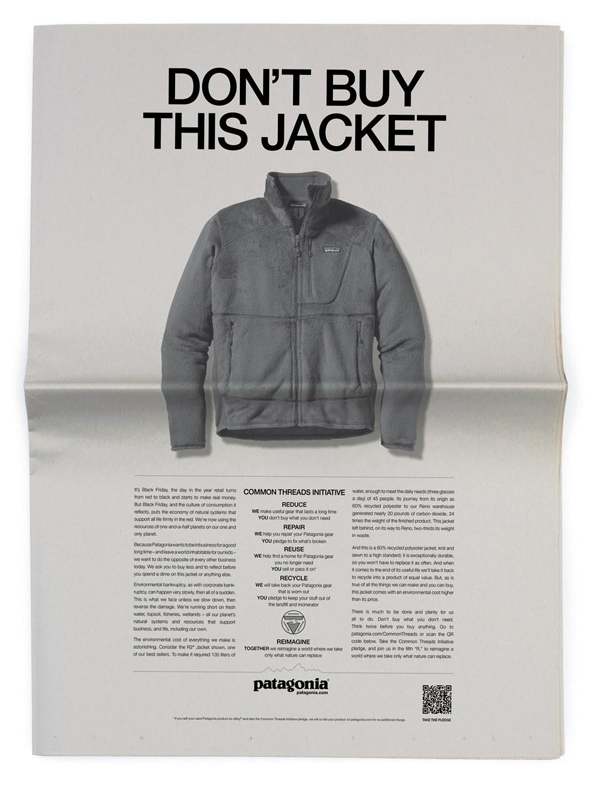
- Nirmal Abraham
On November 25, 2011, American Clothing Brand Patagonia ran a full-page advertisement on the New York Times titled ‘Don’t Buy This Jacket’, which featured the image of the brand’s own R2 jacket – an outfit it previously used to promote as the ultimate armor for cold conditions.
Critics called it a futile attempt at pushing the marketing envelope, but much to their surprise, Patagonia’s sales skyrocketed – recording an overall increase in revenue of over 40% in less than two years.
The ploy was simple. Along with the big bold heading that read ‘Don’t Buy This Jacket’, the ad contained an account of the carbon footprint Patagonia inflicted on a daily basis, and a list of solutions that would help reduce it’s overall environmental impact.
Schemes like accepting and repairing decades-old apparel from customers for free, paying incentives for employees who opt for public transport and carpooling, and donating 100% of its revenue from Black Friday sales to grassroots charities – were all part of the big Patagonian plan to fight this problem.
Not surprisingly, this subtle display of generosity won the hearts of people. They started buying products from Patagonia like never before, with an increased sense of satisfaction and assurance that they were somehow contributing to an environmental cause.
Long story short, the infamous ‘Do Not Buy’ title actually prompted customers to buy even more.
This exotic technique of capturing the market with an eco-conscious approach is called ‘Green Marketing’.
Whether it is Starbucks announcing the introduction of paper cup recycling bins or IKEA using solar panels to power all its outlets, green marketing has set the tone for many companies around the world to operate in line with environmental demands.

Deception and Half-truths:
While everything from pricing and packaging to promotion on social media is now altered to accentuate environmental responsibility as the number one goal, the proliferation of green tactics across different industries meant that it became increasingly difficult to tell apart bona fide green products from deceptive marketing gimmicks.
Apple, for instance, announced in 2017 that its new Macbook Air laptops and Mac Mini computers would be made of 100% recycled aluminum. This sounded like a sudden, radical change for many, and adulations came pouring in from all corners for it’s ‘revolutionary’ proclamation.
But here’s the little known fact - almost all technology firms use recycled aluminum to produce hardware, and Apple, being a tech-giant, was already using a great amount of it in their production process. All they had to do was stretch the usage to 100 percent to make a ‘green’ headline out of it and boom – they were instantly in the ‘eco-friendly’ class.
Of course, Apple contributes socially in several other ways but in this case, they were able to boost the sales of their products, without significantly increasing the use of recycled aluminum in production - a major PR win, so to speak.
Fiji Water too, capitalized on the eco-wave, with alluring advertisements and marketing campaigns that displayed captions such as “untouched by man” and “every drop is green” to subtly influence the choice of buyers.
Although Fiji collects relatively pure water, it still packs it in plastic bottles that take nearly 450 years to degrade, and carries them to all parts of the world via different modes of transport that emit carbon dioxide - polluting air, water and soil in the process.
Fashion brand H & M’s Garment Collection Program also falls in this category, where the old clothes you provide is claimed to be either re-worn or recycled in exchange of a discount coupon that you could use to buy a brand new cloth from their store.
For a scheme that aims to curb consumerism, the coupon system sure sounds a little dubious.
Fortunately, a lot of these firms have started taking steps in the right direction, thanks to the timely intervention of eco-activists. But the million-dollar question is - how did they succeed in the first place?
One of the major contributing factors is the unsuspecting nature of customers. Very few buyers understand the concept of ‘greenwashing’ so it is easier to appeal to their moral conscience with aesthetically pleasing advertisements, vaguely worded captions and lush green packaging that evoke an instant sense of eco-consciousness.
The only way this can be combated is by thoroughly researching the company’s actual environmental contribution on an yearly basis. Are they sourcing it ethically? Is the net effect of the purchase carbon-neutral? Are the claims verifiable? These are all questions eco-conscious customers should ask themselves before proceeding with the purchase.
Getting caught in the act:
Interestingly, not all firms get away with pulling the wool over the customer’s eyes.
Eni, one of Europe’s largest oil companies, was fined $5.94 million for making false claims about the diesel it has been selling since 2017 in the Italian market. By spending heavily on television commercials, digital media advertisements, and public promotion, Eni created the impression that their palm oil-based biodiesel saved fuel and reduced air pollution – a claim that was later proved to be false.
SC Johnson, a household favorite in the US for 88 years, employed a similar tactic when they launched their first ever window cleaner made with 100% ‘recycled ocean plastic’.
Their claims were soon debunked after it was discovered that the plastics they recycled weren’t actually from the ocean, but were retrieved from the banks in Haiti, Indonesia and the Philippines.
Given that they recycled plastic that would otherwise have leaked into the ocean anyway, it may not be a malicious distortion - but one that certainly fits into the category of ‘greenwashing’.
Any product that relies purely on suggestive pictures, decorative language, confusing jargon and zero supporting evidence, may well be greenwashing you into buying a product for all the wrong reasons. Unless you make informed decisions based on actual research, you may well be incentivizing this deception.